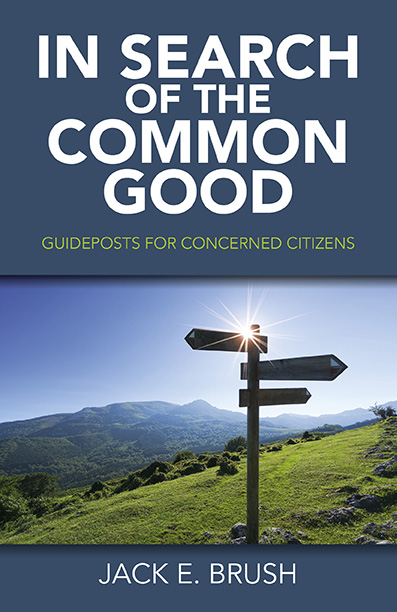
 This stimulating book is a sequel to Citizens of the Broken Compass,
which I reviewed in Network 118, and is subtitled ‘guideposts for concerned citizens.’ It is a wide-ranging historical review of the relationship between law and order in a cosmic sense and in a
moral sense. The theme of the common good was also discussed in the previous book, and some themes reappear here.
This stimulating book is a sequel to Citizens of the Broken Compass,
which I reviewed in Network 118, and is subtitled ‘guideposts for concerned citizens.’ It is a wide-ranging historical review of the relationship between law and order in a cosmic sense and in a
moral sense. The theme of the common good was also discussed in the previous book, and some themes reappear here.The distinctions the author makes between power, force and violence are timely in view of current events. For him, force compels and coerces, while power persuades and convinces; when force becomes destructive, it crosses over into violence. In this context, power and violence are inversely proportional, and by these definitions the US is in fact a superforce rather than a superpower, aiming as it does at full spectrum dominance. Moral authority, the author contends, stems from power rather than force, and here there is an interesting parallel with Stephan Schwartz’s notion of beingness in his book reviewed in another section.
For Brush, the most sympathetic of the ancients is the Stoic Cicero, whom he quotes at some length. For the Stoics, natural law permeates the universe like a membrane and can be apprehended through reason; the law is immanent rather than imposed. Hence Cicero writes that ‘law is the highest reason, rooted in nature... and established in the human mind.’ (p. 21) Acting morally is acting in accordance with the common good corresponding to the connectivity of things; ‘human beings are born the sake of human beings’ according to Cicero. Interestingly, Brush argues that the loss of this cosmic dimension of imposed law led to a literalistic interpretation of the Bible.
Descartes, Newton and Kant all contributed to the emergence of a mechanistic view that separated the physical or cosmic from the moral. For Descartes, law was grounded in the immutability of God,
while the metaphor of the machine allows no free will or purpose. It was only a matter of time before God was eliminated from this universe and we thus find ourselves subject to moral nihilism with
no reliable basis for establishing moral values and making moral decisions.
Darwin and Freud further contributed to this process where the emphasis is shifted from rational in the phrase ‘rational animal’ to ‘rational animal’ subject to powerful sexual drives. In addition,
historicism reinforced this process by demonstrating the cultural relativity of values.
Brush advances a new departure, starting from an analogy of physical constants as fixed points, with the self experienced as a centre of unity and continuity. He then proposes three polarities or axes of human behaviour: force – power, life – spirit and time – eternity. His distinction between force and power, defined above, exactlycorresponds to the system of David Hawkins, who is not mentioned here and whose work could have added to the argument. Although he does not formulate it like this, the author could have added a further polarity of individual - social. In relation to society, he proposes that these polarities become processes of self-knowledge, self-actualisation and the transformation of relationships. The full expression of these processes is hampered by excessive individualism, itself related to property rights described by Locke and incorporated in the American constitution. This sets up a tension between individual interests and the common good, where the corresponding interests are seen to be freedom and national security. Brush makes less use of holistic arguments from modern science here than in his earlier book, but he does describe the evolution of our modern emphasis on human rights from Hobbes, where the individual is the building block of society rather than being embedded in it.
He develops three guideposts for compliance with natural law: respectful dialogue, opportuneness of action and community building. He applies these to specific situations by way of explanation, but cautions that the last guidepost has been subverted by consensus building through manipulation of public opinion going back to Freud’s nephew, Edward Bernays, in the aftermath of the First World War. What is really at stake here is the relationship between metaphysics and ethics, which is the underlying theme of my book Whole in One, subtitled ‘the near death experience and the ethic of interconnectedness.’ My proposal is that mystical experience and the life review - as well as parallels in depth psychology, physics, biology and ecology - point to an underlying oneness of life, being and consciousness so that we are in a very real sense one another. In this context, the golden rule is not only ethical, but ultimately logical.
The moral order of interconnectedness is embedded in a metaphysic of the oneness of consciousness. Having said all this, I applaud the highlighting of the common good, which we must now apply on
planetary scale rather than pursuing selfish nationalism at the expense of the whole and indeed of Nature.
~ David Lorimer, Network Review
Buy the paperback - AMAZON US AMAZON UK INDIEBOUND
Buy the ebook - AMAZON US AMAZON UK HIVE INDIEBOUND
Categories:
0 comments on this article







